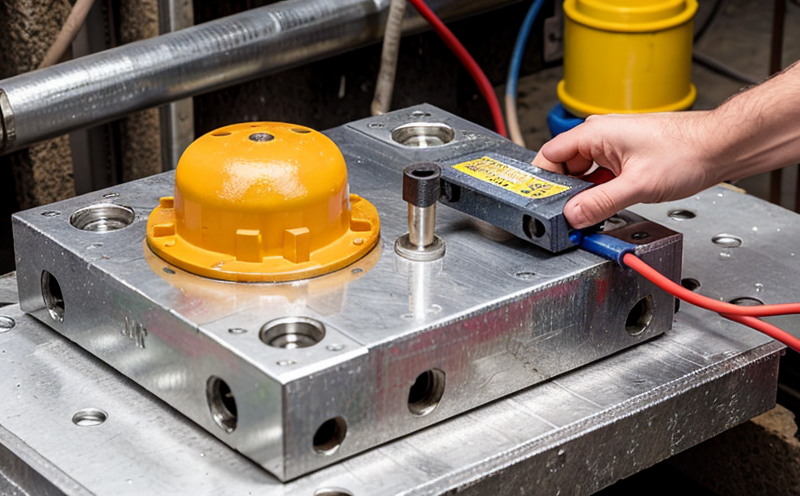Limit switch inspection
The inspection of limit switches is a critical component in ensuring the safe and efficient operation of lifting equipment and cranes. Limit switches are essential safety devices designed to prevent overtravel, which can lead to catastrophic failures or accidents. These devices are typically found at the end points of crane travel paths, ensuring that the movement of the load is halted before reaching an unsafe position.
The primary objective of limit switch inspection is to verify the integrity and functionality of these safety mechanisms. This involves a thorough examination of the mechanical components as well as electrical connections to ensure they meet the specified performance criteria outlined by relevant international standards such as ISO, EN, or ASTM. The inspection process includes checks for wear and tear, misalignment, corrosion, and proper calibration.
During an inspection, technicians use specialized tools and equipment to evaluate the switch's response time, endurance under load, and overall reliability. This ensures that the device can accurately perform its role in safeguarding personnel and preventing equipment damage. Compliance with stringent industry standards is crucial for maintaining operational safety and preventing potential incidents.
Limit switches are subject to environmental factors such as humidity, temperature variations, and exposure to industrial pollutants, all of which can contribute to degradation over time. Regular inspections not only enhance operational efficiency but also extend the lifespan of the equipment by identifying issues early on. This proactive approach is vital in industries where downtime can lead to significant financial losses.
Given the critical nature of these safety devices, it's imperative that inspections are conducted by qualified and experienced personnel who possess the necessary certifications. Using advanced diagnostic tools such as multimeters and oscilloscopes provides accurate data on the switch's performance parameters, ensuring compliance with specified standards. This detailed approach allows for precise identification of any discrepancies or potential failures.
Understanding the specific requirements and challenges faced by different sectors enhances the relevance of inspections. For instance, in the construction sector, where heavy lifting equipment operates in harsh environments, it's essential to consider factors like dust accumulation and mechanical stress on switches. In contrast, for manufacturing plants with automated systems, focus shifts towards electromagnetic interference (EMI) and signal integrity.
In summary, a comprehensive limit switch inspection ensures that these safety mechanisms are reliable and capable of performing their intended function. By adhering to strict standards and utilizing advanced diagnostic techniques, we can provide clients with peace of mind knowing that their lifting equipment is safe and operational at peak performance levels.
Industry Applications
The inspection of limit switches plays a pivotal role across various industries, ensuring safety and compliance with regulatory standards. In the construction sector, where heavy machinery operates in challenging environments, regular inspections are crucial to prevent accidents caused by overtravel or misalignment issues. For manufacturing plants that rely on automated systems, precise calibration and performance checks of limit switches help maintain operational efficiency and product quality.
- Construction Sector: Ensures safety in the operation of cranes and hoists used for material handling and installation tasks.
- Manufacturing Industry: Supports the accuracy and reliability of automated systems, reducing downtime and ensuring product consistency.
- Aerospace: Critical for maintaining precision in complex lifting operations during aircraft maintenance.
- Mining: Vital for operating large-scale equipment safely within hazardous environments.
In each of these sectors, the inspection process focuses on verifying that limit switches are functioning correctly and adhering to stringent safety protocols. This ensures not only compliance with international standards like ISO 9401 but also contributes significantly to overall operational efficiency and safety.
International Acceptance and Recognition
The inspection of limit switches is widely recognized and accepted across numerous international standards, reflecting the importance placed on this aspect of safety in lifting equipment. Organizations such as ISO (International Organization for Standardization), EN (European Norms), and ASTM (American Society for Testing and Materials) have established guidelines that must be adhered to ensure consistent quality and reliability.
Compliance with these standards not only enhances operational safety but also facilitates easier international trade. Many countries, particularly those participating in global supply chains, require conformity with recognized international norms to avoid disruptions caused by non-compliant equipment. This uniformity ensures that lifters can operate seamlessly across borders without compromising on safety measures.
Furthermore, adherence to these standards is often a prerequisite for insurance coverage and regulatory approvals. By ensuring that limit switches meet the specified criteria, businesses can avoid costly penalties or delays associated with non-compliance. The emphasis on international acceptance underscores the global nature of modern manufacturing and construction processes, where safety is paramount regardless of geographical location.
It's worth noting that while these standards provide a framework for best practices, specific requirements may vary depending on local regulations and industry-specific needs. Therefore, it's essential to consult with experts familiar with both international norms and regional compliance issues when planning inspections or upgrades involving limit switches.
Use Cases and Application Examples
- Cranes in Heavy Industrial Facilities: Ensuring that the limit switch operates correctly prevents overtravel, which could lead to equipment damage or personnel injury.
- Lifting Equipment in Warehousing Operations: Regular inspection of limit switches guarantees smooth operation and reduces maintenance costs due to premature failures.
- Agricultural Machinery: Proper calibration ensures that lifting operations are precise, reducing the risk of product damage during loading and unloading processes.
- Railway Maintenance Cranes: These cranes operate in close proximity to tracks, making accurate limit switch inspection essential for preventing derailments or collisions with other trains.
In each scenario, the primary goal is to ensure that the limit switch functions correctly, thereby enhancing overall safety and operational efficiency. By adhering to strict standards and employing advanced diagnostic techniques during inspections, we can provide clients with reliable solutions tailored to their specific needs.





